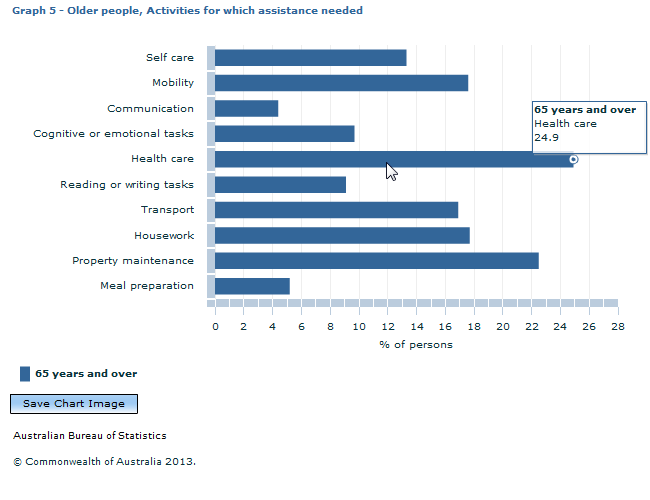4430.0 - Disability, Ageing and Carers, Australia: Summary of Findings, 2012  Quality Declaration
Quality Declaration
ARCHIVED ISSUE Released at 11:30 AM (CANBERRA TIME) 13/11/2013
Page tools:
 Print Page Print Page
 Print All Print All
| ||||
Age related conditions can lead to older people requiring assistance with everyday types of activities, ranging from household chores and property maintenance, to using transport and paying bills. Therefore, people aged 65 years and over were asked about their need for assistance with these tasks, regardless of whether they were considered to have a disability. In 2012, around 1.4 million older people needed assistance with at least one activity because of disability or age (42%). Assistance was most commonly needed for health care tasks (25%) and property maintenance (23%). (Table 27 and Graph 5)  Source(s): ABS Survey of Disability, Ageing and Carers, Australia: Summary of Findings-2012 The need for assistance for older persons differed between the sexes, with almost half of older females (49%) reporting a need for assistance with at least one activity, compared with around a third of older males (34%). Females were more likely than males to have needed assistance with household chores (23% compared with 12%), mobility (21% compared with 14%) and transport (20% compared with 14%) (Table 27). Of those who needed assistance, the common informal providers were their spouse or partner (34%) or their daughter (22%). Common formal sources were private commercial organisations (37%) and government organisations (30%). (Table 29) Of those people with disability, living in households, older people were more likely to report that their need for assistance had been met in full than those aged under 65 years (64% compared with 58%), while a similar proportion reported that their needs were not met at all (around 2% for each group). (Table 14)
|
||||
